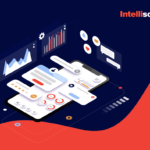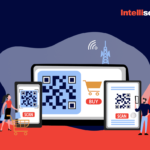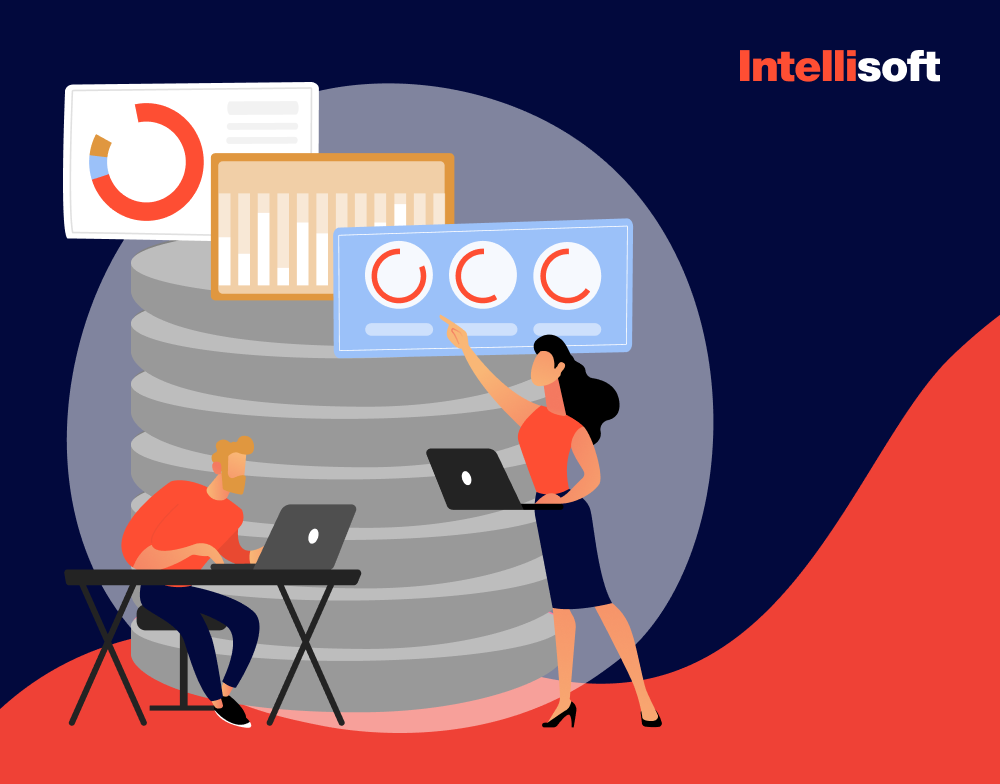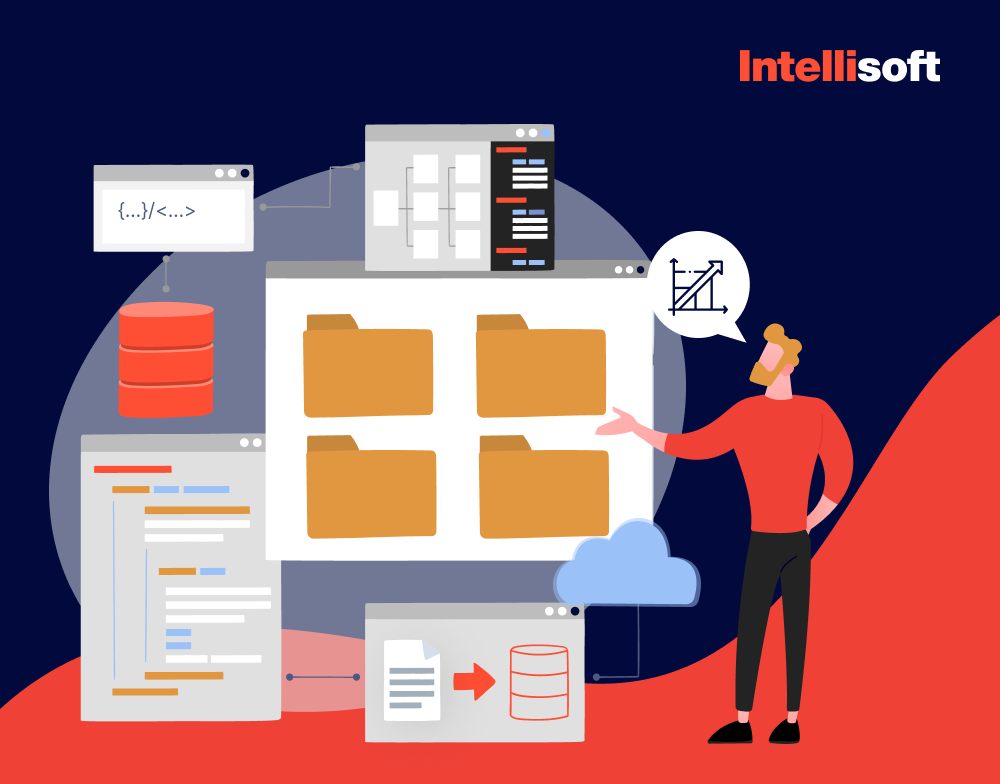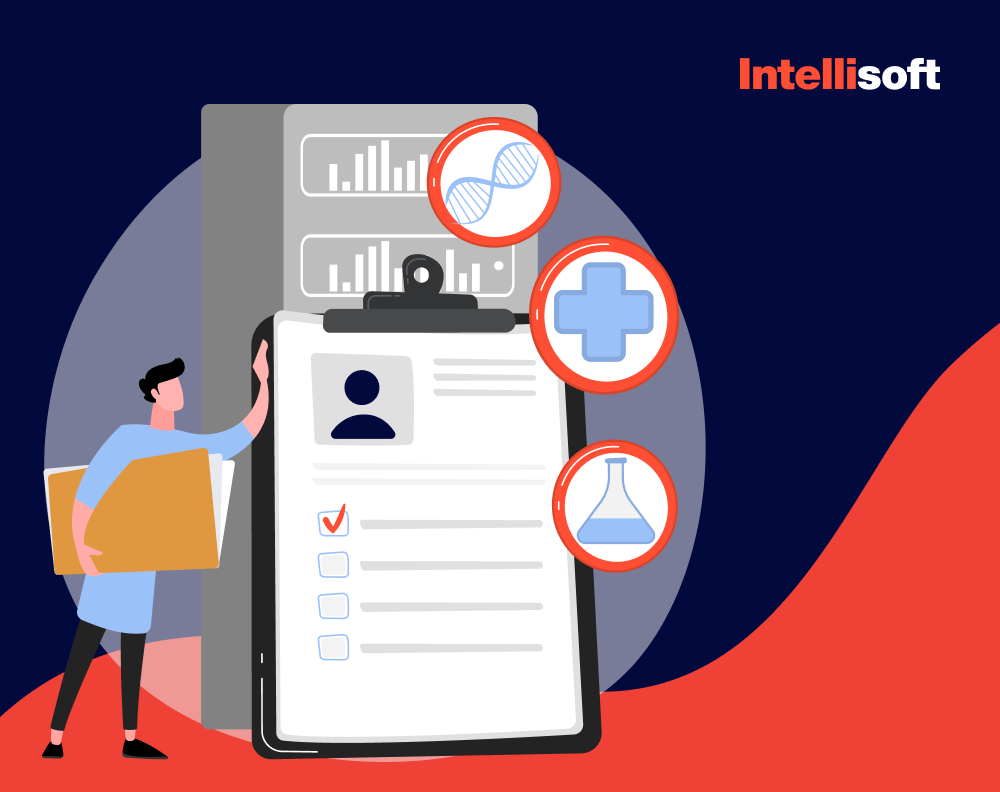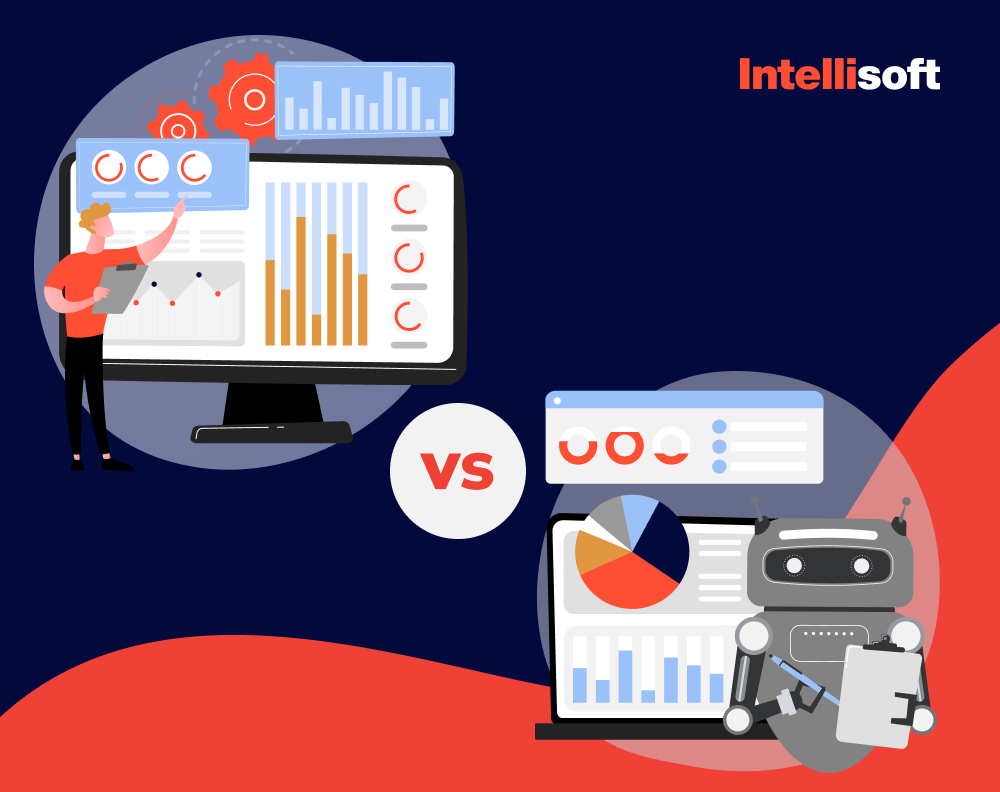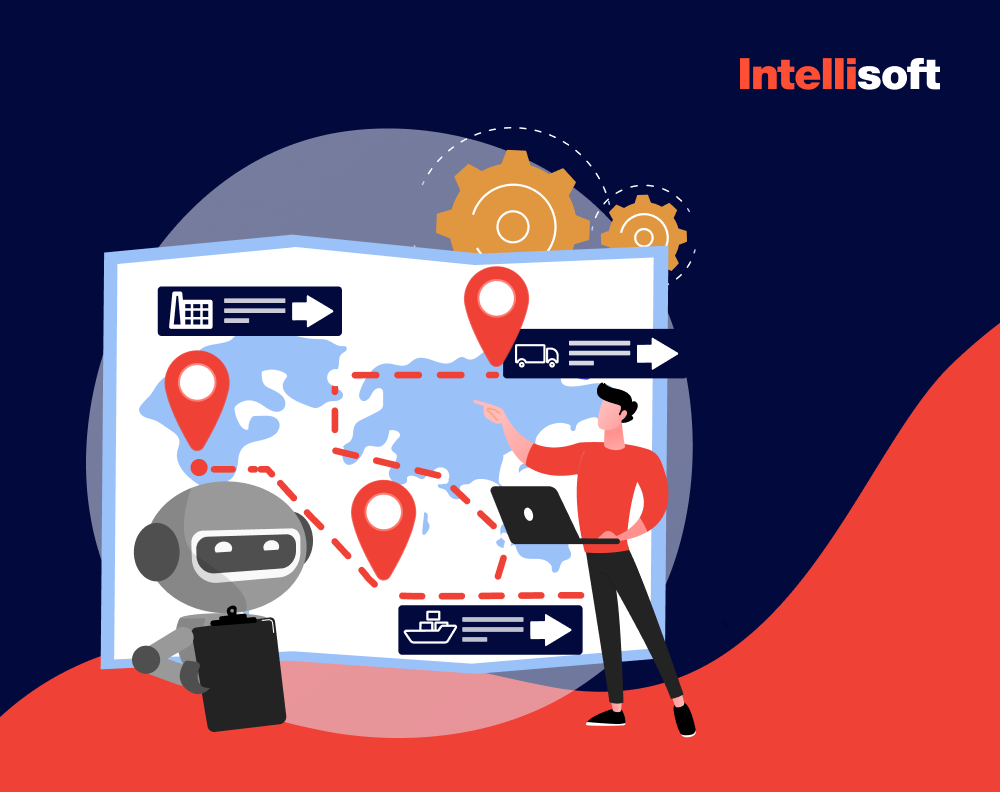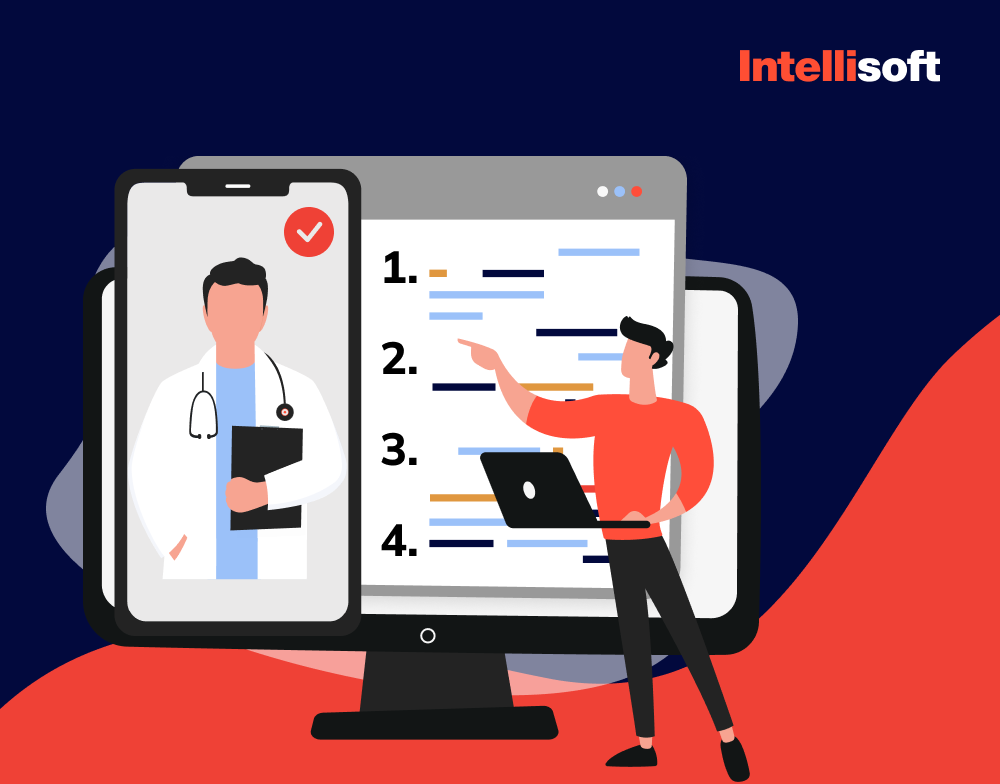As a business owner, you know when the moment to grow your business comes, and you start thinking about the next logical steps. One of the main ways to expand your business and reach a wider audience is by building SaaS applications. You can either transform your current software into a SaaS app or hire a SaaS software development service to develop it from scratch.
The evolution towards SaaS is not merely a technological shift; it is a strategic move that offers unparalleled opportunities for scalability, enhanced user experiences, and market penetration. Whether you’re contemplating the transformation of existing software or envisioning a SaaS solution developed from scratch, this guide on how to build software as a service will empower you with the knowledge and confidence to make informed decisions.
With more than 10 years of experience in SaaS development, IntelliSoft can be your guide in this endeavor. We will navigate you through the intricacies of building a SaaS product, providing insights into the strategic considerations that will shape your journey.
The transformative power of SaaS awaits, and this SaaS development guide is your compass for a seamless journey into the future of business innovation.
Table of Contents
SaaS Market Statistics
Before jumping into the SaaS development guide, let’s explore recent SaaS market statistics and insights.
- According to Statista, the global SaaS market generated 167 billion U.S. dollars in revenue in 2022 – accounting for approximately two-thirds of the entire public cloud services market revenue.
- A report by Gartner predicts that by 2025, 85% of new software will be delivered as SaaS.
- DigitalOcean states that 53% of developers prefer to use cloud services for their SaaS application development needs, while 43% prefer to use on-premise infrastructure.
- Nearly 90% of IT professionals surveyed note that automation is key to managing SaaS operations, but 64% say they lack the resources to automate.
- From 2023 to 2030, the expected compound annual growth rate (CAGR) for the global SaaS market is 13.7%.
- According to a report by PwC, SaaS companies spend an average of 17% of their revenue on research and development, compared to an average of 12% for other software companies.
What is SaaS Application Development?
“SaaS” stands for Software as a Service, and SaaS application development refers to the process of creating and delivering software applications through the internet on a subscription basis. In a SaaS model, instead of purchasing and installing software on individual computers or servers, users can access the application through a web browser.
For example, popular SaaS apps include Grammarly, Slack, GSuite, Dropbox, and others.
Key characteristics of SaaS application development include:
- Subscription-based: Users typically pay a recurring fee for access to the software, often on a monthly or annual basis. This subscription model provides a more predictable and scalable revenue stream for both users and developers.
- Accessibility: SaaS applications are accessible through a web browser, eliminating the need for users to install and maintain the software on their local devices. This makes it easier for users to access the application from any device with an internet connection.
- Automatic Updates: SaaS providers are responsible for maintaining and updating the software. Users receive automatic updates without having to manually install new versions, ensuring that they always have access to the latest features and security patches.
- Scalability: SaaS applications are designed to scale easily to accommodate varying numbers of users. This scalability allows businesses to adjust their subscription levels based on their current needs.
- Multi-tenancy: SaaS applications are often designed with a multi-tenant architecture, meaning that a single instance of the software serves multiple customers (tenants). This shared infrastructure helps reduce costs and resources.
- Data Security: SaaS providers typically implement robust security measures to protect user data. However, users should still be aware of the security policies and practices of their chosen SaaS providers.
Why is SaaS Popular?
SaaS (Software as a Service) has gained widespread popularity for several reasons, and its adoption continues to grow. If you’ve been thinking how to build a SaaS product and what its benefits are, here are some key advantages of SaaS contributing to the popularity of SaaS:
Cost-Effective
SaaS eliminates the need for users to invest in hardware, infrastructure, and physical software licenses. Instead, users pay a subscription fee, making it a more cost-effective option, especially for small and medium-sized businesses with limited IT budgets.
Accessibility and Flexibility
SaaS applications are accessible from any device with an internet connection and a web browser. This accessibility enhances flexibility, allowing users to work from various locations and devices, promoting remote work and collaboration.
Scalability
SaaS applications are designed to scale easily, allowing businesses to adapt to changing user numbers and requirements. This scalability is particularly beneficial for growing companies that need to expand or contract their usage of software resources.
Automatic Updates
SaaS providers handle software maintenance, updates, and patches. This relieves users from the burden of manual updates, ensuring that they always have access to the latest features, improvements, and security enhancements.
Rapid Deployment
With SaaS, users can quickly deploy and start using software without the need for lengthy installation processes. This rapid deployment accelerates time-to-value and allows businesses to be more agile in responding to market demands.
Reduced IT Overhead
SaaS eliminates the need for organizations to manage and maintain complex IT infrastructures. The responsibility for hardware maintenance, software updates, and security measures falls on the SaaS provider, reducing the burden on internal IT teams.
Subscription Model
The subscription-based pricing model of SaaS provides a predictable and often more manageable cost structure for users. This model allows businesses to budget more effectively and align software costs with usage.
Collaboration and Integration
Many SaaS applications are designed with collaboration in mind. They often offer integrations with other popular tools, promoting seamless communication and data sharing among different software platforms.
Global Access
SaaS applications can be accessed globally, facilitating collaboration among teams and individuals regardless of their geographical location. This is particularly advantageous for businesses with distributed or remote teams.
Focus on Core Competencies
SaaS allows businesses to focus on their core competencies rather than spending time and resources on managing IT infrastructure. This can lead to increased efficiency and innovation within the organization.
Overall, the convenience, cost-effectiveness, and flexibility offered by SaaS make it an attractive option for businesses of all sizes and industries, contributing to its widespread adoption and popularity.
SaaS Applications Architecture
There are a couple of different approaches to SaaS applications architecture. Here’s how to develop a SaaS application and what architecture to choose from:
Multi-Tenant
Multi-tenancy SaaS applications architecture involves a single infrastructure serving multiple customers, with each tenant’s data isolated and secured from others. There are two ways to implement this approach:
- One app instance, one database: In this setup, all users entering the cloud environment access the same database. While it is easy to implement, its scaling capabilities are limited, impacting overall app performance and user experience.
- One app instance, several databases: In this approach, each database is filled up to a certain point before redirecting new users to another database. This provides users with access to more resources, resulting in a more responsive software experience. However, this approach is more expensive to implement and requires additional resources upfront.
Single-Tenant
In this case, single-tenant SaaS architecture means that every customer uses their own instance of the software. This model is better secured than the multi-tenant one, but it is more challenging to support and maintain.
Horizontal SaaS
Horizontal SaaS architecture caters to a broad spectrum of businesses across different industries. Examples include accounting or marketing apps that companies from various niches can utilize.
Vertical SaaS
Vertical SaaS architecture, on the other hand, is specifically crafted for a particular business vertical. These apps are not intended for use across diverse industries; rather, they offer more specialized and tailored feature sets for distinct user segments within a specific vertical.
Types of SaaS Applications
Depending on what industry the application is built for, SaaS apps can be classified into the following types:
- Customer Relationship Management (CRM). CRM applications are designed to assist businesses in managing and optimizing their interactions with customers. These tools typically offer features such as contact management, lead tracking, and sales analytics to enhance customer satisfaction and streamline sales processes.
- Enterprise Resource Planning (ERP). ERP applications provide an integrated solution for managing and coordinating various business processes within an organization. From financial management and human resources to inventory control, ERP systems aim to improve overall efficiency by consolidating disparate functions into a unified platform.
- Billing and Accounting. SaaS applications in this category focus on financial management, invoicing, and accounting. They empower businesses to handle billing processes, manage expenses, and ensure accurate financial reporting, contributing to sound financial practices.
- Project and Task Management. These SaaS applications are designed to facilitate effective project planning, organization, and task tracking. Project management tools empower teams to collaborate seamlessly, ensuring timely completion of tasks and successful project outcomes.
- Communication Tools. SaaS communication tools are essential for enhancing collaboration within organizations. These applications encompass a range of features, including instant messaging, video conferencing, and file sharing, to foster efficient communication and connectivity among team members.
These categories represent a snapshot of the diverse SaaS landscape, with applications tailored to meet the specific demands of different industries. The continuous evolution of technology and the increasing demand for specialized solutions contribute to the ongoing expansion and refinement of SaaS offerings across various sectors.
Benefits of SaaS Development
This SaaS application development guide also covers the main benefits of software as a service. SaaS development has numerous advantages for those who decide to invest in it. The main advantages of SaaS include:
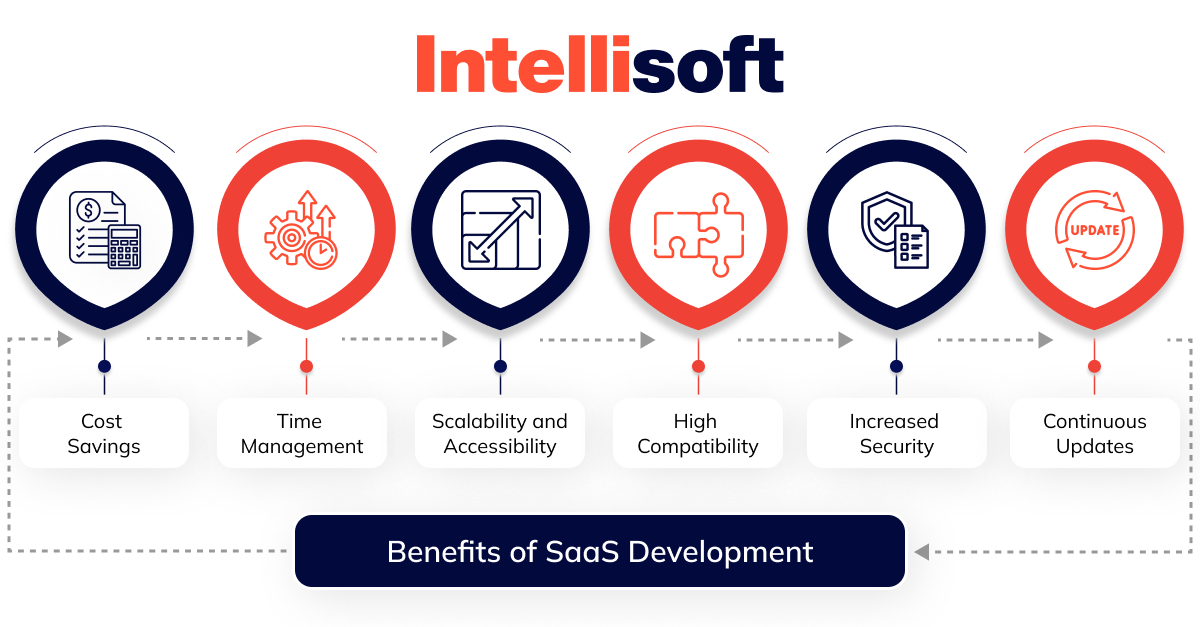
Cost Savings
SaaS development stands out for its notable cost-saving advantages, reshaping the traditional landscape by eliminating the burden of upfront expenses linked to software procurement and installation. Embracing a subscription-based model, businesses gain access to sophisticated software solutions without the weighty initial financial commitments.
Moreover, the encompassing nature of SaaS subscriptions, covering ongoing maintenance, updates, and support within the subscription fee, contributes significantly to a reduced Total Cost of Ownership (TCO). This financial approach offers organizations a streamlined and economically favorable path for adopting and sustaining powerful software solutions.
Time management
Efficiency in implementation and streamlined maintenance processes characterize the time-management benefits inherent in a SaaS solution. Unlike traditional software, SaaS platforms are designed for rapid deployment, bypassing the complexities of extensive installations and intricate hardware setups.
The time saved in the implementation phase allows businesses to swiftly integrate and capitalize on the software, directing their efforts toward core activities. Furthermore, the burden of software infrastructure management is alleviated as SaaS providers assume responsibility for maintenance tasks, updates, and patches, allowing organizations to optimize their time for strategic priorities.
Scalability and Accessibility
One of the main advantages of SaaS is scalability. SaaS development offers great scalability, empowering businesses to seamlessly adjust their software usage in tandem with fluctuations in user numbers. The flexibility to modify subscription plans ensures organizations pay only for the resources they require, creating a dynamic and cost-effective model. Simultaneously, the accessibility of SaaS applications from any device with an internet connection enhances flexibility and fosters collaboration across geographically dispersed teams. This accessibility feature not only aligns with modern work dynamics, but also contributes to improved operational efficiency.
High Compatibility
The cross-platform compatibility of SaaS applications is also among the main benefits of SaaS development. These applications are designed to be accessible through web browsers, ensuring compatibility across various operating systems and devices. Users can seamlessly access the software from Windows, macOS, Linux, or mobile platforms without encountering compatibility issues. This adaptability enhances user experience and broadens the reach of the software to cater to diverse technological environments.
Increased Security
Security is a paramount consideration in SaaS development, and providers invest significantly in robust measures to safeguard the central infrastructure. This includes implementing data encryption, conducting regular security audits, and adhering to industry standards. Automatic updates from SaaS vendors ensure that the software is equipped with the latest security patches, significantly reducing the risk of vulnerabilities. This commitment to security instills confidence in users regarding the protection of sensitive data and contributes to a secure computing environment.
Continuous Updates
One of distinctive advantages of SaaS development lies in the continuous updates provided by vendors. These updates introduce new features and improvements regularly, ensuring that users always have access to the latest functionalities without the need for manual interventions. This continuous evolution not only enhances the user experience but also enables businesses to stay competitive by promptly adapting to changing needs, incorporating emerging technologies, and responding swiftly to user feedback.
What Are SaaS Platform Development Peculariaties?
Before learning how to build a SaaS product, you need to consider several non-technical factors, such as:
Databases
A database is a critical component of any information system, requiring careful consideration for optimal performance. It should be extensive, flexible, secure, and aligned with business objectives. The choice of database type is influenced by factors such as data nature, scalability, anticipated load, read-to-write balance, budget, and programming language compatibility. Striking the right balance ensures efficient data management and sets the foundation for future growth.
Scaling
Scalability is a cornerstone consideration in SaaS development. The application should be designed to scale both vertically and horizontally, ensuring it can gracefully handle increased demands. This scalability should not be an afterthought but an integral part of the development process, aligning seamlessly with the anticipated growth strategy of the business. This proactive approach guarantees that the SaaS platform remains agile and responsive to evolving user needs.
Frequent Updates
In the dynamic landscape of SaaS, a strategy for frequent updates is not just beneficial but essential. Regular software updates serve as a mechanism to introduce new features, enhancements, and security patches. An iterative and proactive approach to updates ensures that the SaaS application remains competitive, adaptable, and aligned with the evolving expectations of its user community. This ongoing evolution is vital for staying ahead in a rapidly changing technological environment.
Third-Party Integrations
The ability to seamlessly integrate with third-party services significantly enhances the functionality and versatility of a SaaS application. This involves careful consideration of Application Programming Interfaces (APIs) and integration capabilities. By allowing users to leverage a broader ecosystem of tools and services, a SaaS platform becomes more than a standalone solution, enriching the overall value proposition and expanding its utility across diverse business scenarios.
Performance and Reliability
Performance and reliability are non-negotiable aspects that directly impact user satisfaction. Ensuring swift response times, minimal downtime, and efficient resource utilization contribute to a positive user experience. Rigorous testing, optimization, and adherence to performance benchmarks are essential components in achieving and maintaining high levels of performance and reliability. A robust and reliable SaaS application instills confidence in users and fosters a positive user perception.
Security Measures
Security is a paramount consideration in the development of any SaaS application. Implementing robust security measures is not just a checkbox, but a continuous commitment. This includes data encryption, regular security audits, and strict adherence to industry standards. Proactive security measures not only protect sensitive information but also contribute significantly to building trust among users. A secure computing environment is fundamental to the success and sustainability of a SaaS platform.
Customization and Configurability
User preferences and varied business requirements necessitate a keen focus on customization and configurability. Offering users the ability to tailor the application to their specific needs enhances user satisfaction and broadens the applicability of the platform across diverse user groups. Striking the right balance between providing a feature-rich out-of-the-box solution and allowing room for user-specific adjustments ensures that the SaaS platform caters to a wide range of business scenarios.
User Interface and Experience
The user interface (UI) and overall user experience (UX) are pivotal factors influencing user adoption and retention. An intuitive, visually appealing interface, coupled with a seamless user experience, contributes significantly to the overall success of a SaaS application. Investing in a well-designed and user-friendly interface enhances the overall usability and acceptance of the platform. An application that is not only functional but also enjoyable to use fosters positive user engagement and strengthens the platform’s competitive edge.
Related Readings:
- How to Build an iOS App for Your Start-up in 2023
- How to Create a Location-Based App: a Complete Guide
- How to Make a Social Media App: Detailed Guide
- How to Make Your Cross-Platform App That Thrives: A Step-by-Step Guide
- Web Development vs Mobile Development: What to Choose?
Best SaaS Examples
Before developing SaaS applications, you can gather inspiration from the established SaaS platforms, such as Microsoft 365, Dropbox, Slack, and others.
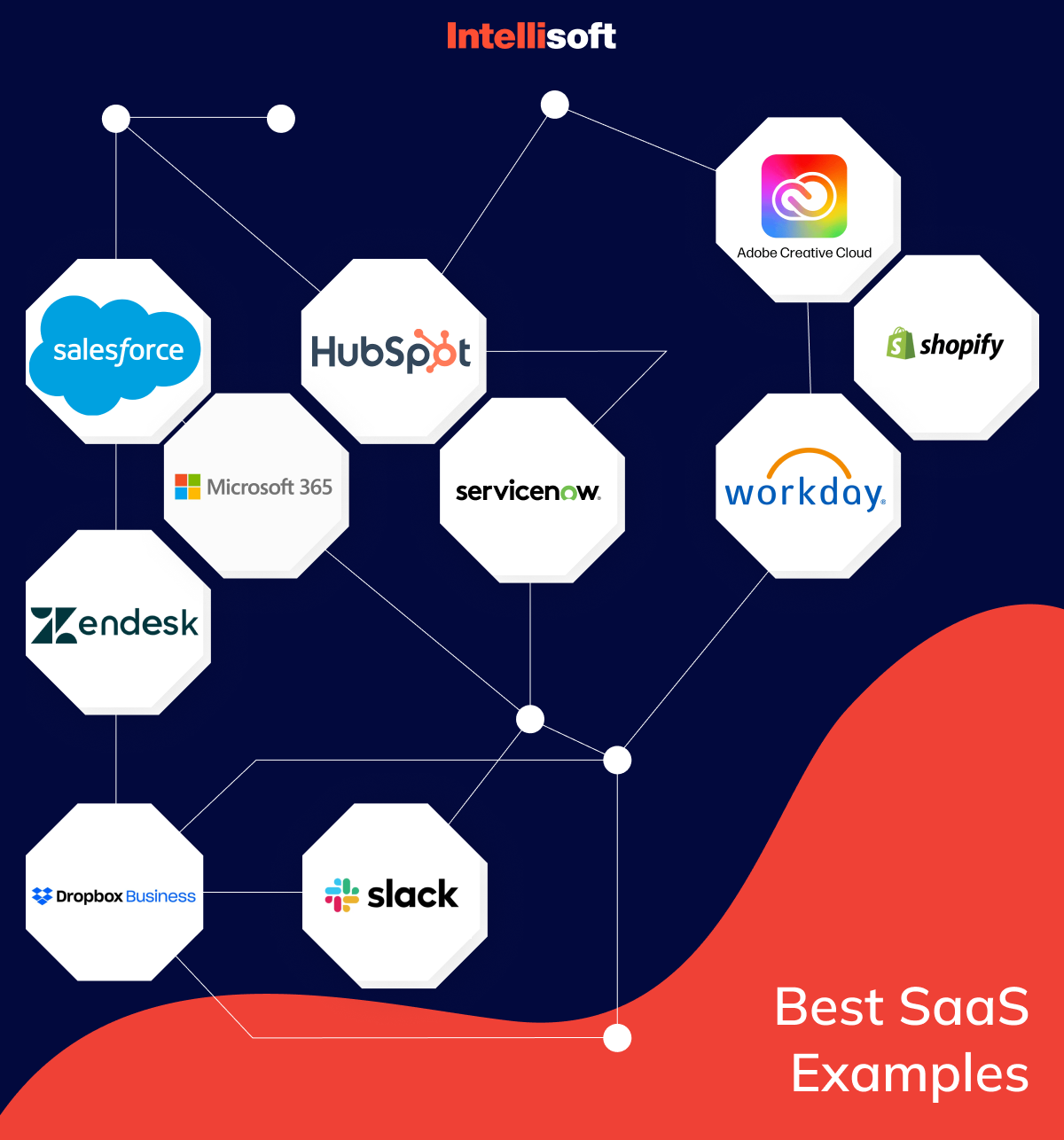
1. Salesforce:
- Industry: Customer Relationship Management (CRM)
- Key Features: Salesforce offers a comprehensive suite of CRM tools, empowering businesses to manage customer relationships, sales processes, and analytics in a centralized platform.
2. Microsoft 365:
- Industry: Productivity and Collaboration
- Key Features: Formerly known as Office 365, Microsoft 365 provides a suite of productivity tools, including Word, Excel, PowerPoint, and collaborative platforms like Teams and SharePoint.
3. Zendesk:
- Industry: Customer Support
- Key Features: Zendesk is a customer support platform that streamlines communication between businesses and their customers, offering tools for ticketing, knowledge base management, and live chat.
4. Dropbox Business:
- Industry: Cloud Storage and Collaboration
- Key Features: Dropbox Business is a cloud storage solution that facilitates file sharing, collaboration, and secure data storage, enhancing team productivity and accessibility.
5. Slack:
- Industry: Team Communication and Collaboration
- Key Features: Slack is a team collaboration platform that facilitates real-time messaging, file sharing, and integration with various third-party applications, fostering efficient communication within organizations.
6. HubSpot:
- Industry: Inbound Marketing and Sales
- Key Features: HubSpot offers an integrated platform for inbound marketing, sales, and customer service, providing tools for lead generation, CRM, and marketing automation.
7. ServiceNow:
- Industry: IT Service Management (ITSM)
- Key Features: ServiceNow is a cloud-based platform that helps organizations manage IT services, automate workflows, and optimize business processes.
8. Adobe Creative Cloud:
- Industry: Creative Software Suite
- Key Features: Adobe Creative Cloud provides a suite of creative tools, including Photoshop, Illustrator, and Premiere Pro, enabling professionals to create and collaborate on digital content.
9. Workday:
- Industry: Human Capital Management (HCM)
- Key Features: Workday offers a cloud-based platform for human resources, providing solutions for HR management, payroll, and workforce planning.
10. Shopify:
- Industry: E-commerce
- Key Features: Shopify is an e-commerce platform that allows businesses to create online stores, manage products, and handle transactions, providing a streamlined solution for online retailers.
SaaS Development Guide: How to Develop a SaaS Application?
If you have been wondering how to develop a SaaS platform and what steps you should take to ensure its success, here’s how to build software as a service:
- Ensure the feasibility of your concept
- Formulate a concept and product plan
- Develop a robust business plan
- Specify requirements for SaaS platform development
- Choose an appropriate tech stack
- Assemble a competent SaaS development team
- Build the SaaS app and implement post-launch maintenance
Let’s take a look at how to build a SaaS product.
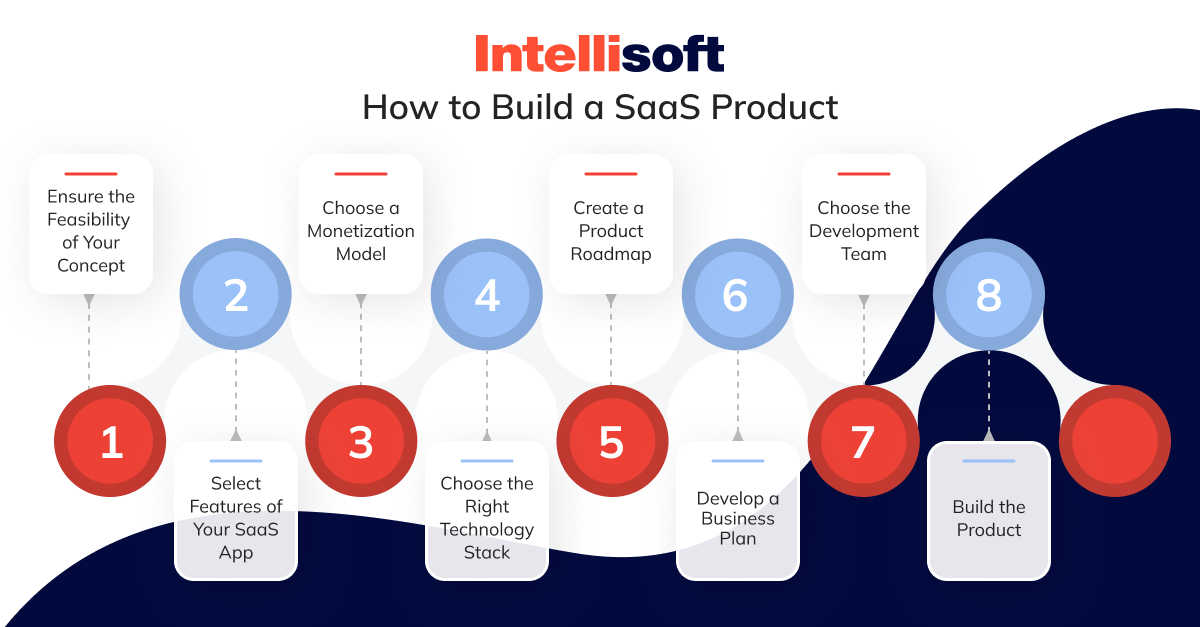
Ensure the Feasibility of Your Concept
Before you invest your time and money into building a product, you must ensure that your product will meet real user needs, solve their issues, and have a potential market. In other words, you should validate your idea. Here’s how to do that:
- Research the market. Analyze the industry, looking for similar products and your main competitors. This will help you uncover the latest SaaS development trends and see whether there are any gaps in the market that you can address with your product.
- Identify your target audience. The next logical step is to identify who your target audience is. You should know who will use your product, what issues it will solve, what the users’ pain points are, and what functionality they would like to see. To learn more about the target audience, you can conduct interviews and surveys with them.
- Evaluate the existing products. Select a couple of similar existing products in the market and thoroughly evaluate their strengths and weaknesses. This way, you’ll be able to create a unique value proposition (UVP) and create a unique app that is highly competitive in the market.
After completing these steps, start working on your product concept, which is essential for future development, marketing, and execution of the idea. The concept should include:
- Problem statement: a description of the issues the product will solve and how it will do it.
- Value proposition: your product’s unique benefits and value.
- Target market description: details about your target audience, such as their demographics, jobs, preferences, pain points, and any other critical information.
Select Features of Your SaaS App
The features of your product should set you apart from the competitors and offer solutions everyone else can’t offer. Thus, before you start the SaaS app development process, conduct a competitive analysis to define what features and functionality your customers want to see most.
Here’s how you can do that:
- Identify your main business goals
- Identify users’ needs
- Write opportunity statements
- Think of feature ideas
- Prioritize features
The top three priorities when coming up with features should be customer needs, feasibility, and impact on the core value proposition.
Still, there are common must-have features that you should always include in your SaaS apps:
- User authentication
- Data security (data masking, access controls, password policy)
- Intuitive user interface
- Customer support
Choose a Monetization Model
Navigating the intricacies of developing SaaS applications that ensure a steady stream of income demands thoughtful consideration, particularly when selecting a revenue model. The challenge lies in striking a delicate balance between delivering value to customers and securing fair compensation for your product, all while maintaining competitiveness in the market.
Here are the most popular pricing models that you can consider:
- Per-User Pricing
Commonly employed for team-oriented products like CRMs and project management tools. Involves charging customers based on the number of employees utilizing the solution. - Tiered Pricing
Ideal for cloud solutions catering to diverse user needs. Offers multiple packages with varying features at different price points, allowing for revenue growth and customer flexibility. - Per Storage Pricing
Simple and straightforward model. Customers pay based on the amount of storage they require, with the option to access paid packages for additional storage. - Feature-Based Pricing
Ties the pricing of the cloud-based application to the available features. Encourages users to upgrade their packages for enhanced functionality, providing a clear incentive for progression. - Pay As You Go
Pricing varies based on the frequency of product usage. Suited for SaaS products in high demand, where revenue scales with increased usage. - Subscription
A transparent model offering a single product with specific features at a set price. - Freemium
Customers access basic functionality for free, with advanced features available in paid packages. - Ads-Supported Pricing
Similar to freemium it generates revenue through advertisements rather than paid features.
Choose the Right Technology Stack
In the realm of SaaS product development, a robust tech stack is pivotal for success. Here are the commonly utilized web development technologies across various facets of SaaS application development:
Back-End Technologies
- Programming Languages: Node.js, Django, Ruby on Rails
- Frameworks and Libraries: Leveraging these technologies ensures the dynamic and reliable functioning of the SaaS app’s server side. Node.js, known for its scalability, and frameworks like Django and Ruby on Rails are recommended choices.
Front-End Technologies
- Advanced Technologies: Angular.js, React.js, Vue.js
- Web Page Elements: Front-end technologies encompass buttons, menus, links, graphics, and other interactive web page elements. Utilizing advanced technologies such as Angular.js, React.js, and Vue.js enhances the user experience in SaaS application development.
Databases
- Primary Data Store: PostgreSQL
- Additional Choices: MySQL, Redis
- Role: Databases serve as the foundation for cloud-based solutions. PostgreSQL is the primary data store for its reliability, and MySQL and Redis complement the tech stack, providing versatility in handling different data structures.
Hosting and Infrastructure
- Cloud Hosting Providers: Amazon Web Services (AWS), Digital Ocean
- Other Services: Azure, Heroku, Google Cloud Platform (GCP)
- Functionality: Hosting and infrastructure are critical components. AWS and Digital Ocean are preferred cloud hosting providers, offering scalability. Additionally, services like Azure, Heroku, and GCP provide diverse solutions for SaaS developers.
SaaS Mobile App Development
- iOS Development: Swift, Objective-C
- Android Development: Java, Kotlin
- Cross-Platform Solutions: Flutter, React Native
- Versatility: For mobile app development, SaaS leverages Swift and Objective-C for iOS, Java, and Kotlin for Android, and cross-platform solutions such as Flutter and React Native, ensuring adaptability across different platforms.
| Tech Stack | Strengths | Weaknesses |
|---|---|---|
| LAMP (Linux, Apache, MySQL, PHP/Python/Perl) | Boasting a solid reputation and widespread usage, the LAMP stack is cost-effective, supported by numerous open-source tools, and particularly well-suited for content-heavy applications. | It may not scale as seamlessly as newer stacks, and performance concerns can arise, especially in high-demand scenarios. |
| MEAN (MongoDB, Express.js, Angular, Node.js) | Leveraging the power of full-stack JavaScript, the MEAN stack offers simplified development, scalability for real-time applications, and popularity in dynamic web app creation. | It falls short when handling CPU-bound tasks, making it less ideal for such computational workloads. |
| MERN (MongoDB, Express.js, React, Node.js) | Tailored for single-page applications (SPAs), the MERN stack streamlines development through consistent use of JavaScript, resulting in heightened developer productivity. | It may not be the optimal choice for features requiring real-time data synchronization. |
| Ruby on Rails (RoR) | Renowned for rapid development and a developer-friendly syntax, Ruby on Rails is favored for startups and prototyping, emphasizing quality through convention over configuration (CoC). | Performance issues may emerge under very high loads, and it may not be the top choice for computationally intensive tasks. |
| Serverless (AWS Lambda, Azure Functions, Google Cloud Functions) | Emphasizing clean and readable code, the Serverless architecture excels in complex, data-driven applications, backed by a robust ecosystem and an active community. | It is confined to specific use cases, and concerns about vendor lock-in may limit its broader applicability. |
Create a Product Roadmap
The next step in the SaaS application development guide is creating a product roadmap.
Now that the product vision is well-defined and features have been identified and prioritized, the next crucial step is to estimate the project scope and construct a roadmap. This roadmap will serve as a guiding framework for building your SaaS product, ensuring coherence with your vision and responsiveness to user needs.
Initiate the process by establishing milestones for SaaS application development, including the release date for the Minimum Viable Product (MVP) and subsequent releases. Begin by clearly articulating the overarching objectives for the SaaS application.
Identify key phases, encompassing ideation, MVP development, beta testing, feature enhancements, scalability improvements, and ongoing maintenance. Each phase plays a pivotal role in the evolutionary journey of your SaaS product.
Determine timeframes for each milestone, factoring in considerations such as task complexity, resource availability, and dependencies between milestones. This meticulous planning ensures a realistic and achievable timeline for the development process.
Visualize the roadmap template, illustrating the timeline and key milestones. This can be executed using various tools, including Gantt charts, spreadsheets, or specialized roadmap software, providing a clear and accessible overview of the project’s progression.
Extend your planning beyond the MVP by outlining subsequent releases and iterations. Specify which features and enhancements will be incorporated in each release, laying the groundwork for continued product development and improvement.
Recognize the dynamic nature of the SaaS landscape by planning for flexibility. As you gain more insights into your product and market, periodically revisit and adjust your roadmap. This adaptive approach ensures that your development strategy remains responsive to evolving requirements and opportunities.
Develop a Business Plan
To make more informed business decisions, you need a well-structured, detailed business plan. This plan should consist of:
- Executive summary, which is an overview of your business, product, target market, value proposition, and financial goals.
- Company description, its mission, values, and vision. You should clearly explain why your product will be unique and how you will succeed in the market.
- Market research should include analysis of industry trends, competitor analysis, and the needs and preferences of your target audience.
- Product description should cover the product’s unique features, how it addresses users’ pain points, and how it offers value to people.
- Sales and marketing strategy covers details on customer acquisition, SEO, lead generation, paid advertising, and various sales channels.
- The product development roadmap should include an explanation of how you’re planning to build and grow a SaaS app.
- Financial projections covering funding requirements and profitability estimates. You should mention whether you’re looking for external funding and how you’re going to use the funding to grow your business.
- Team members, their goals, expertise, and qualifications. You should also mention your recruitment plans if you need to cover any gaps in your team.
- KPIs will help you track your business’ progress. Include user acquisition goals, churn rates, and revenue targets.
Risk analysis and mitigation strategies.
Choose the Development Team
When considering the recruitment of software development specialists for SaaS product construction, you have three viable options at your disposal:
Hiring Freelancers
- Pros: Cost-effective approach to building a SaaS product.
- Cons: Reliability concerns may arise as the quality of services can vary. Inconsistent work quality may necessitate additional time and expenses for revisions.
In-House Development Team
- Pros: Provides complete control over the SaaS development process.
- Cons: Can be financially burdensome due to expenses such as software licensing, hardware, taxes, salaries, and compensation.
Outsourcing to a Software Development Company
- Pros: Enables avoidance of operational expenses associated with in-house teams.
- Cons: Offers a dedicated team of highly qualified professionals, including SaaS developers, UX/UI designers, quality assurance engineers, and project managers experienced in delivering reliable cloud-based products. This approach ensures adherence to industry standards and customization to meet specific business needs.
Build the Product
The SaaS development process is typically segmented into the following key stages:
Discovery Session
- Purpose: Familiarize your development partner with your project and business.
- Outcome: Defines the project scope and provides accurate time and cost estimates.
UX/UI Design
- Purpose: Involves creating wireframes and clickable prototypes to conceptualize your product visually.
- Outcome: Provides a tangible representation of the user experience and interface design.
Development
- Purpose: Involves the actual coding of the application.
- Approach: Agile methodology is highly recommended, particularly for startup projects or those with inherent uncertainties.
Quality Assurance
- Purpose: Ensures that each product feature functions correctly and the system is free from bugs or glitches.
- Outcome: Guarantees the reliability and seamless performance of the developed solution.
Deployment and Launch
- Purpose: Makes the solution accessible to both search engines and real users seeking your services.
- Outcome: Initiates the product’s live presence, allowing users to engage with the solution.
Post-Launch Operations
- Set up performance monitoring and promptly address bugs and issues that may arise.
- Actively collect user feedback through surveys, customer support interactions, and user analytics to guide future enhancements and optimizations.
This structured approach ensures a comprehensive and systematic progression from project initiation to ongoing refinement, fostering a SaaS product that, not only meets initial requirements, but also evolves in response to user feedback and market dynamics.
What is the Best SaaS Tech Stack?
Selecting the right technology stack is a pivotal decision in SaaS development, influencing the performance, scalability, and efficiency of your product. The best SaaS tech stack depends on various factors, including project requirements, scalability needs, and development team expertise. Here are key considerations for each component:
1. Back-End Technologies:
- Node.js: Ideal for real-time applications, scalable, and widely adopted.
- Django and Flask (Python): Known for clean and pragmatic design, suitable for rapid development.
- Ruby on Rails: Promotes convention over configuration, facilitating rapid development.
2. Front-End Technologies:
- React.js: Efficient for building interactive user interfaces.
- Angular.js: Offers a comprehensive framework for dynamic web applications.
- Vue.js: Lightweight, versatile, and easy to integrate.
3. Databases:
- PostgreSQL: Provides reliability and supports complex queries.
- MongoDB: Ideal for flexible and scalable databases, especially for unstructured data.
- MySQL: Known for its stability and compatibility.
4. Cloud Hosting Providers:
- Amazon Web Services (AWS): Offers a wide range of services, highly scalable.
- Microsoft Azure: Strong enterprise support, and seamless integration with Microsoft products.
- Google Cloud Platform (GCP): Known for data analytics and machine learning capabilities.
5. Mobile App Development:
- iOS (Swift, Objective-C): Robust and efficient for Apple devices.
- Android (Java, Kotlin): Widely used languages for Android app development.
- Cross-Platform (Flutter, React Native): Streamlines development for both iOS and Android.
6. Serverless Architecture:
- AWS Lambda, Azure Functions, Google Cloud Functions: Enables scalable, event-driven applications with reduced operational overhead.
Ultimately, the best SaaS tech stack is one that aligns with your project goals, development team expertise, and scalability requirements. Regularly reassess and adapt your stack based on emerging technologies and evolving project needs to ensure the continued success of your SaaS venture.
SaaS Development Guide: Pricing
The cost of building a SaaS solution depends on the product you want to create, its features, deadlines, and the team you’re working with. In fact, a huge part of the end cost is the salaries you pay to developers, be it an in-house team or outsourced developers.
One of the most cost-effective tips on how to build SaaS product is to consider outsourcing software development. Here’s an overview of outsourcing prices in different countries:
India
India has long been a popular outsourcing destination due to its large pool of skilled IT professionals. Hourly rates for software development in India can range from $15 to $35, depending on the level of expertise and the technology stack.
Ukraine
Ukraine is gaining popularity as an outsourcing destination due to its highly skilled workforce and competitive rates. Hourly rates typically range from $25 to $45.
Poland
Poland has a strong reputation for quality software development. Hourly rates in Poland can vary between $30 and $50, making it a slightly higher-cost option compared to some other outsourcing destinations.
Mexico
Mexico is close to the United States and has a growing tech industry. Hourly rates can vary between $30 and $50, making it a competitive option for companies in the Americas.
China
China is often chosen for manufacturing outsourcing, but its IT industry is also growing. Hourly rates for software development can range from $20 to $40.
United States
In the U.S., software development rates can vary significantly based on the region and the level of expertise required. Onshore development rates typically range from $50 to $150 per hour, with some specialized skills commanding even higher rates.
Canada
Canada is an attractive outsourcing destination with a highly skilled workforce. Hourly rates for software development in Canada generally range from $40 to $100, depending on the specific skills and location.
United Kingdom
The United Kingdom is another European destination for outsourcing. Hourly rates for software development in the UK can vary widely but generally fall within the range of £40 to £100.
SaaS Development Team Composition
The composition of a SaaS (Software as a Service) development team is crucial for the successful creation, deployment, and maintenance of a SaaS product. The team structure may vary depending on the size and complexity of the project, but here’s a general overview of key roles in a SaaS development team:
Product Manager
Responsible for defining the product vision, strategy, and roadmap. Works closely with stakeholders to gather requirements, prioritize features, and ensure the product aligns with business goals.
Project Manager
Oversees the day-to-day activities of the development team. Manages timelines, and resources, and ensures that the project stays on track. Facilitates communication between team members and stakeholders.
UI/UX Designer
Designs the user interface and overall user experience of the SaaS application. Focuses on creating an intuitive and visually appealing design that enhances user satisfaction.
Software Architects
Define the overall structure of the software system. They make high-level design decisions, choose the appropriate technologies, and ensure that the system components work seamlessly together.
Backend Developers
Responsible for server-side development. They build the logic and functionality that powers the application, including databases, server scripts, and application programming interfaces (APIs).
Frontend Developers
Focus on client-side development, creating the user interface, and ensuring a smooth user experience. They work with technologies like HTML, CSS, and JavaScript to bring the design to life in the web browser.
Full-Stack Developers
Developers who have expertise in both frontend and backend technologies. They can work on all aspects of the application, from the user interface to the server-side logic.
DevOps Engineers
Responsible for the development, deployment, and maintenance processes. They automate tasks, manage infrastructure, and ensure a smooth and efficient development and deployment pipeline.
Quality Assurance (QA) Engineers
Test the software to identify and fix bugs before the product is released. They work to ensure the quality, reliability, and performance of the SaaS application.
What Are Challenges in SaaS Application Development?
SaaS (Software as a Service) application development comes with its set of challenges, ranging from technical complexities to business considerations. Here are some common challenges faced during SaaS application development:
Security and Compliance
Ensuring the security of user data and compliance with privacy regulations (e.g., GDPR, HIPAA) are paramount. SaaS developers must implement robust security measures and stay abreast of evolving threats and compliance requirements.
Scalability
Designing the SaaS application architecture to handle scalability challenges is critical. As user bases grow, the system must seamlessly scale to meet increased demand without sacrificing performance.
Integration Complexity
Integrating with other systems and third-party services can be complex. SaaS applications need to ensure smooth interoperability, providing APIs and connectors for seamless data exchange.
Continuous Delivery and Deployment
Implementing effective CI/CD processes is crucial for rapid and reliable releases. SaaS development teams must ensure seamless updates and deployments to minimize downtime and improve user experience.
User Experience (UX) Design
Designing an intuitive and user-friendly interface is a critical challenge. Balancing functionality with simplicity and addressing diverse user needs contribute to the overall success of a SaaS application.
How to Migrate Your Web Application to SaaS?
Migrating a traditional web application to a SaaS (Software as a Service) model involves a strategic approach to ensure a smooth transition for both your organization and your users. Here is a step-by-step guide on how to migrate your web application to SaaS:
- Assessment and Planning: Understand your current application and define the SaaS model. Assess user impact and plan for a smooth transition.
- Architecture Adjustment: Optimize for multi-tenancy, scalability, and performance.
- Data Migration: Back up data, map, and transform it for the new architecture. Use migration tools and validate data integrity.
- Security Measures: Enhance security protocols and ensure compliance.
- User Authentication and Authorization: Implement SSO and RBAC mechanisms for access control.
- Subscription and Billing System: Set up a billing system aligned with your business goals. Clearly communicate changes in pricing and plans.
- User Interface (UI) and User Experience (UX): Optimize UI for responsiveness and user experience. Provide customization options for branding.
- Testing: Conduct thorough testing, including functional, security, and performance testing.
- Deployment and Monitoring: Deploy in phases to minimize disruption. Implement monitoring tools for post-deployment performance.
- User Training and Support: Offer documentation, training sessions, and user support.
- Feedback and Iteration: Collect user feedback and iterate based on user needs.
SaaS Development With IntelliSoft
If you decide to outsource your SaaS developers to professionals, it’s important to find vendors with the most relevant experience and development cases. Finding a perfect match in the global talent pool is not an easy task, but you’ve already found one. InteliSoft has more than 10 years of experience in SaaS development, ready to become your guide in this journey. One of our biggest clients has been GrowthWheel – a Danish consulting company founded in 2005.
The company’s main goal was to create visual tools for business consultants and help entrepreneurs increase their productivity in making data-based decisions. The IntelliSoft development team released the first version of the SaaS platform with basic functionality in just 30 business days.
Thanks to well-documented processes, the experienced development team, and dedication to the client’s business goals, IntelliSoft was honored to become the GrowthWheel dedicated R&D center. Currently, our team is continuing to work on project maintenance and the integration of new features.
As a result of the successful cooperation of IntelliSoft and GrowthWheel teams, the project’s MVP has turned into a full-fledged transformation channel for startups and growing companies. GrowthWheel now covers 64 countries worldwide and shares experience in business consulting management with its clients.
If you have been thinking about hiring an outsourced vendor and need a consultation, contact us, and we will talk about your concept and its potential implementation.
